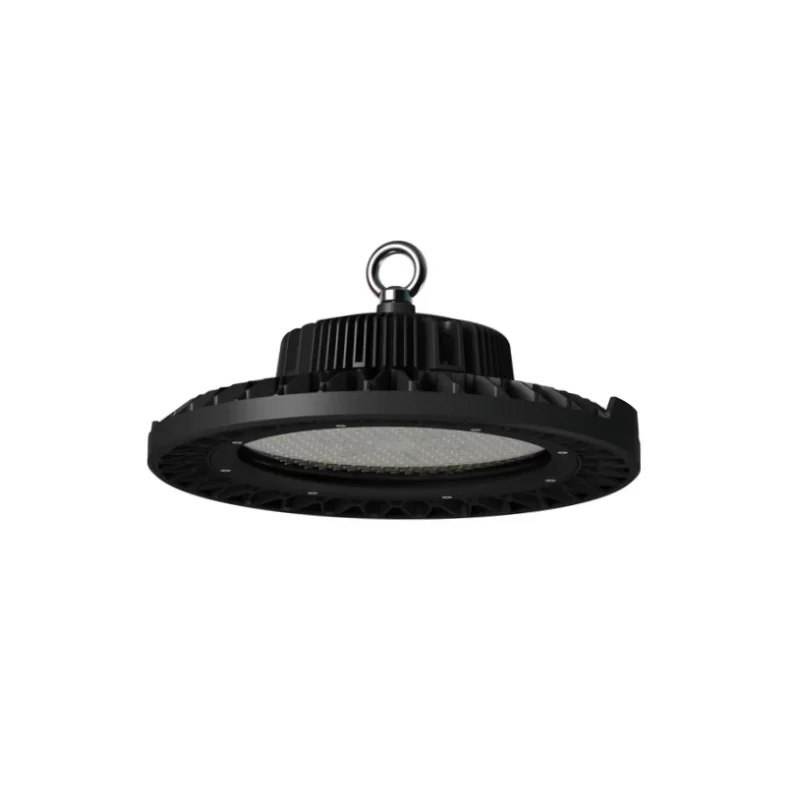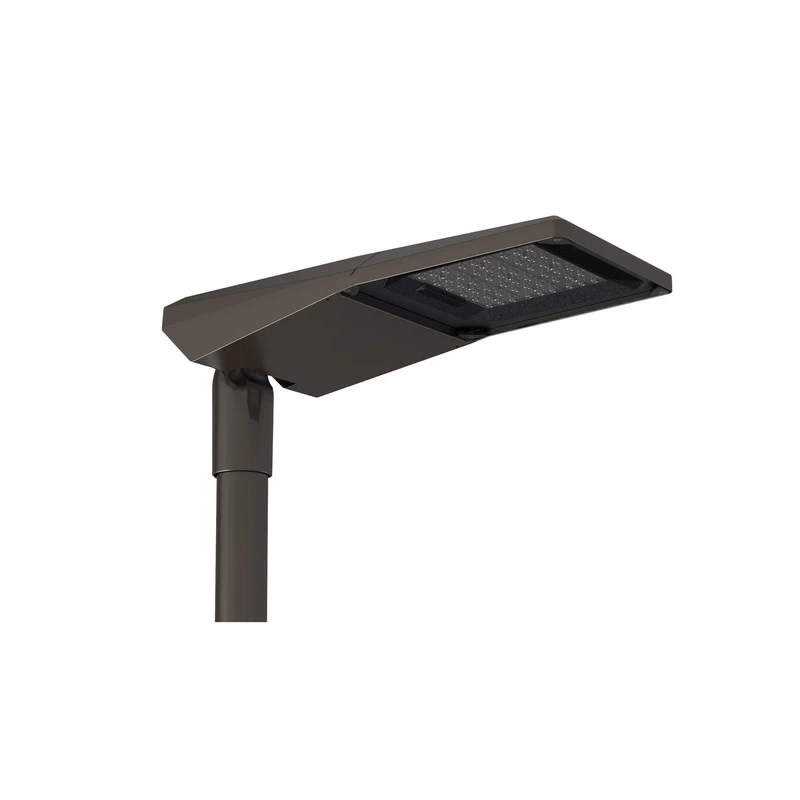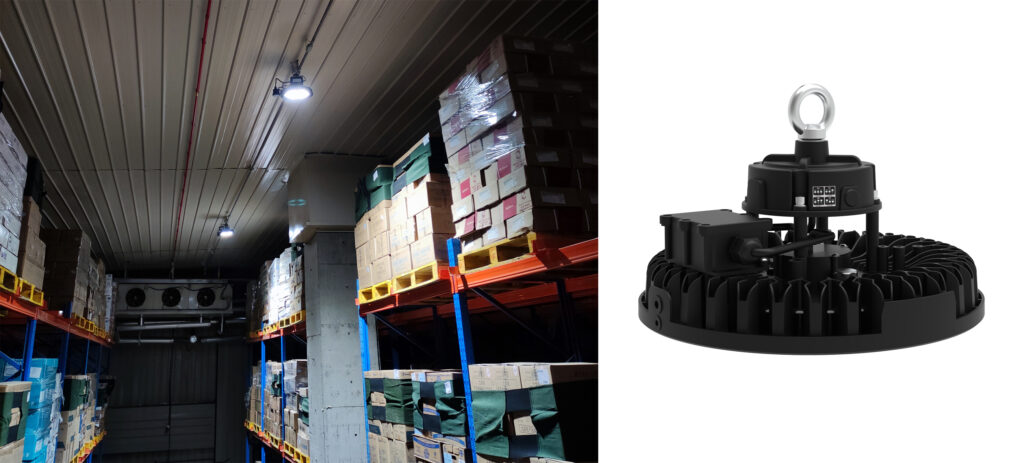Indice dei contenuti
ToggleIntroduzione: Il colore della luce LED e la sua importanza
Il mondo dell'illuminazione può essere travolgente con tutti i diversi tipi di luce a led disponibili. Se si vuole illuminare la casa, l'ufficio, la fabbrica o l'impianto sportivo, è importante scegliere il colore giusto della luce. Aiuta a creare la giusta atmosfera.
La luce diurna e il bianco brillante hanno usi e impostazioni diverse. Le lampadine Soft White e Warm White possono cambiare l'atmosfera di una stanza. Questa guida vi aiuterà a orientarvi tra queste opzioni.
Per ulteriori informazioni su come l'illuminazione influisce sugli ambienti, consultate il nostro articolo sulla luce visibile.
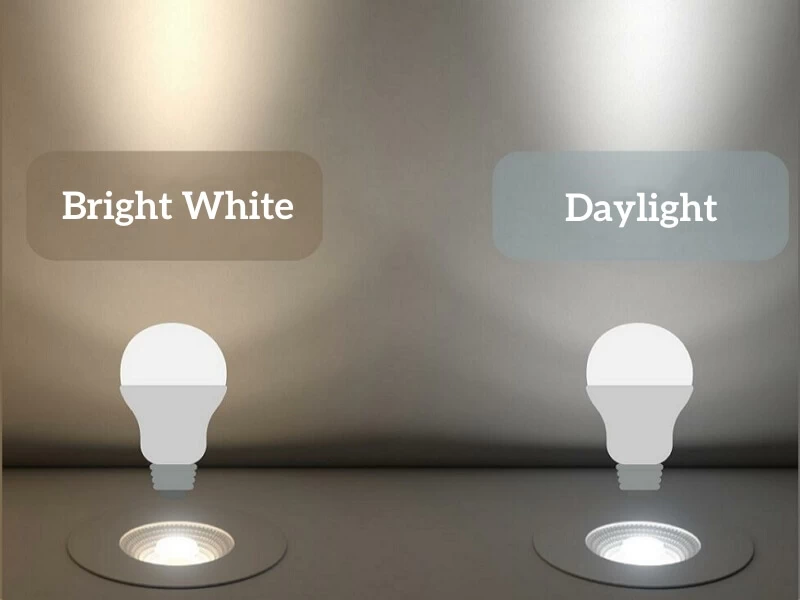
Cosa c'è da sapere su Watt e Kelvin
Prima di addentrarci nei diversi tipi di luce a led, è essenziale comprendere i Watt e i Kelvin:
Cosa sono i Watt?
I watt si riferiscono all'energia consumata da una lampadina. Maggiore è il numero di Watt, più luminosa è la lampada e maggiore è il consumo di energia. Le lampadine a incandescenza tradizionali consumavano molti Watt.
Le moderne lampadine a LED, invece, consumano meno energia. Ma forniscono comunque un'elevata emissione di lumen. Quando si sceglie la lampadina giusta, è fondamentale considerare i watt per garantire l'efficienza energetica.
Cosa sono i Kelvin?
I Kelvin misurano la temperatura di colore della luce emessa dalle lampade LED. I Kelvin più alti producono una luce più fredda e blu, come le lampadine Daylight. I Kelvin più bassi creano una luce più calda e morbida, come le lampadine Soft White.
Tipi di lampadine: Una ripartizione
Prima di immergersi nei diversi tipi di luce a led, è essenziale comprendere i Watt e i Kelvin. Ad esempio, luce diurna, bianco brillante, bianco morbido, bianco freddo e bianco caldo.
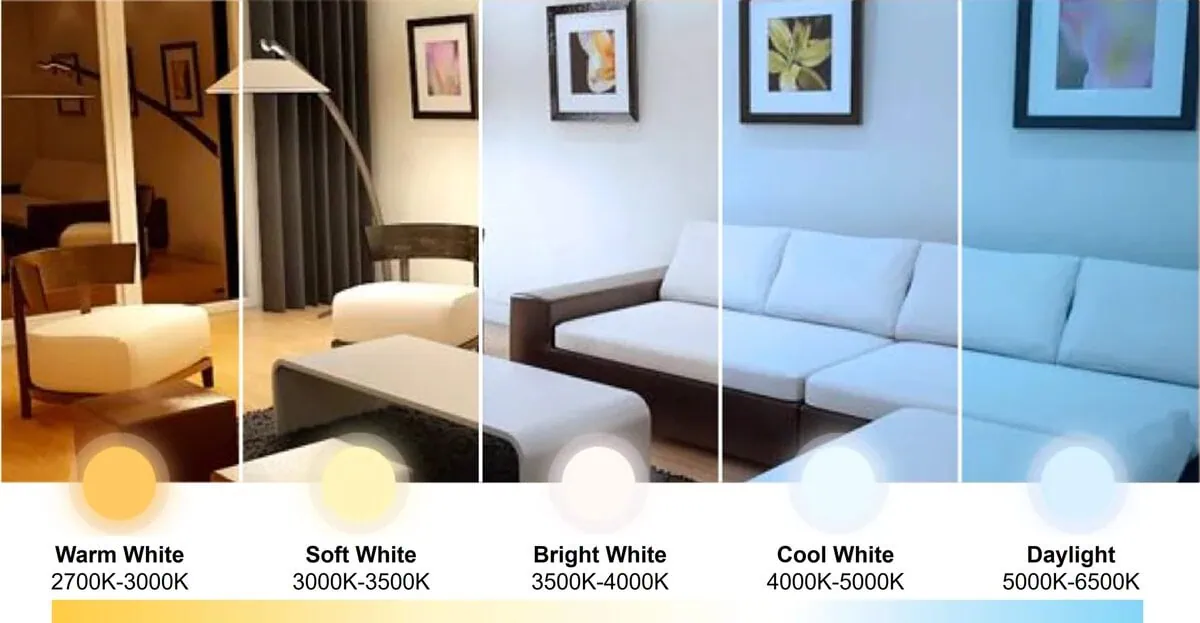
1. Bianco brillante vs lampadine a luce diurna
Sia le lampadine a luce bianca che quelle a luce diurna sono spesso scelte per il loro aspetto nitido e bianco, ma hanno scopi diversi. Le lampadine a luce bianca brillante sono ideali per le attività che richiedono chiarezza, come le cucine o gli uffici. Le lampadine a luce diurna sono realizzate in modo da assomigliare alla luce naturale del sole. Sono ideali per i luoghi in cui è necessaria una luce intensa, come le officine o i garage.
Per le applicazioni commerciali, le lampadine Daylight sono spesso utilizzate in luoghi come showroom, ospedali o grandi uffici. Per saperne di più su come scegliere le migliori lampadine a luce diurna, visita la pagina dei prodotti.
Differenza di base: Temperatura del colore
- Luce diurna: La temperatura di colore varia in genere da 5000K a 6500K. Questa temperatura di colore simula la luce naturale del sole a mezzogiorno.
- Bianco brillante: La temperatura del colore varia in genere da 3500K a 4100K. È una via di mezzo tra il bianco caldo e la luce del giorno.
Differenze visive:
- Luce diurna: Offre una riproduzione dei colori molto accurata, con un bianco chiaro, freddo e leggermente bluastro. Crea un'atmosfera di chiarezza, attenzione, concentrazione, modernità, pulizia e tecnologia. La luce è nitida, con un contrasto relativamente forte delle ombre.
- Bianco brillante: Offre una riproduzione dei colori eccellente e naturale, con un bianco puro, neutro e brillante. Crea un'atmosfera rinfrescante, luminosa, efficiente, equilibrata e neutra. È più "vivace" della luce bianca calda e più "amichevole" e "naturale" della luce diurna. Le ombre sono nitide, ma non abbaglianti.
| Colore chiaro | Caratteristiche visive | Applicazioni tipiche |
|---|---|---|
| Luce del giorno | Luce bianca fredda, nitida e chiara, simile alla luce solare di mezzogiorno | Residenziale: Banconi della cucina, scrivanie da lavoro, aree per il trucco Industriale: Officine, laboratori, attività di precisione, magazzini Commerciale: Display elettronici, ambulatori, aree per i prodotti freschi Sport: Campi da gioco, spogliatoi, aree ad alta visibilità |
| Bianco brillante | Bianco neutro, pulito e nitido, naturalmente luminoso | Residenziale: Bagni, corridoi, illuminazione generale Industriale: Uffici, sale riunioni, corridoi Commerciale: Negozi al dettaglio, showroom, ristoranti, cliniche Sport: Zone fitness, percorsi pedonali, centri benessere |
2. Lampadine a luce bianca morbida o calda
Le lampadine Soft White emettono una luce calda e gialla, ideale per soggiorni e camere da letto che desiderano un'atmosfera accogliente. Le lampadine a luce bianca calda offrono un calore accogliente. Sono ideali per creare un'atmosfera rilassata nelle zone pranzo o nei salotti.
Differenza di base: Temperatura del colore
- Bianco tenue: 2700K - 3000K, emula il calore delle tradizionali lampade a incandescenza/lampade.
- Bianco caldo: 3000K - 3500K, emula il calore delle lampade alogene/alba e tramonto.
Differenze visive:
- Bianco tenue: Una distinta tonalità arancio/ambra, che crea una luce più "gialla". Più ricca e rilassata, crea un forte senso di riposo e privacy.
- Bianco caldo: Una tonalità di bianco-giallastro più tenue, leggermente più bianca del bianco tenue. Caldo, confortevole, amichevole, naturale e leggermente energetico.
| Colore chiaro | Caratteristiche visive | Applicazioni tipiche |
|---|---|---|
| Bianco morbido | Una tonalità giallo caldo, con una possibile leggera diminuzioneResidenziale: Illuminazione della camera da letto principale, illuminazione d'ambiente del soggiorno a tarda notte e illuminazione della cena a lume di candela nei ristoranti. Commerciale: Ristoranti, bar, caffetterie, camere e corridoi occidentali | |
| Bianco caldo | I colori degli oggetti appaiono più naturali e caldi, con dettagli leggermente più nitidi rispetto a Soft White e una resa cromatica generalmente migliore. | Residenziale: Illuminazione principale del soggiorno, illuminazione principale della sala da pranzo, illuminazione del portico Commerciale: Ristoranti, caffetterie, panetterie, lobby lounge, dispense |

3. Bianco freddo vs. bianco brillante
Cool White e Bright White sono due tipi di luce bianca neutra o fredda che possono essere facilmente confusi. Ecco le differenze fondamentali, le distinzioni visive e le modalità di scelta:
Differenza di base: Temperatura del colore
- Bianco freddo: 4000K - 5000K, rappresenta efficienza, calma, modernità, tecnologia e pulizia.
- Bianco brillante: 3500K - 4100K, che rappresenta luminosità, freschezza, efficienza, equilibrio e naturalezza.
Differenze visive:
- Bianco freddo: Il bianco freddo ha una tonalità bluastra che può dare agli oggetti una sfumatura leggermente fredda. Crea un'atmosfera più razionale e seria.
- Bianco brillante: Un bianco puro e neutro, senza toni caldi o freddi distinti, che consente agli oggetti di apparire nel loro stato più naturale ed equilibrato.
Considerazioni chiave:
- Cercate calma, efficienza, tecnologia e altissima definizione? Scegliete il bianco freddo (4000K-5000K).
Ad esempio: sale operatorie, laboratori e fabbriche di elettronica. - Cercate un look luminoso, professionale, neutro e naturale? Scegliete il bianco brillante (3500K-4100K).
Ad esempio: uffici, aule, negozi al dettaglio e la maggior parte delle aree commerciali in generale. - Suggerimento semplice:
Cool White = freddezza, tecnologia e serietà
Bianco brillante = neutralità, versatilità e naturalezza

4. Differenza tra luce diurna e bianco tenue
La luce diurna e il bianco tenue sono i due estremi della temperatura di colore e la loro esperienza visiva e gli scenari applicabili sono molto diversi.
- Bianco morbido: Con una temperatura di colore di 2700K-3000K, questa luce è di colore giallo caldo. Crea un'atmosfera calda, rilassante e pigra, con una sensazione di leggera foschia. È adatta alle aree di riposo e relax.
- Luce diurna: Con una temperatura di colore di 5000K-6500K, questa luce è di colore bianco freddo, simile a quella di mezzogiorno. Crea una sensazione rinfrescante, tonificante e persino leggermente fredda. È adatta alle aree di lavoro ad alta concentrazione.
| Tipo | Temperatura del colore (K) | Aspetto leggero | Uso tipico |
|---|---|---|---|
| Luce del giorno | 5000K - 6500K | Bianco fresco e nitido con tonalità bluastre | Uffici, laboratori, lettura, illuminazione per attività |
| Bianco morbido | 2700K - 3000K | Luce calda e accogliente con tonalità giallastra | Salotti, camere da letto, illuminazione d'ambiente |
Fattori chiave per la scelta della lampadina migliore
Ci sono diversi fattori da considerare quando si sceglie la lampadina migliore per le proprie esigenze:
- È più luminoso il bianco brillante o la luce del giorno?
La differenza principale tra le lampadine Bright White e Daylight è la luminosità. Le lampadine a luce diurna hanno in genere valori Kelvin più elevati ed emettono una luce più brillante, perfetta per i lavori di dettaglio. - La differenza tra bianco morbido e bianco caldo
Entrambi i tipi di lampadine creano un'atmosfera calda. Le lampadine Soft White sono più morbide e ideali per ambienti intimi. Le lampadine a luce bianca calda forniscono una luce più intensa e sono perfette per gli spazi commerciali più ampi.
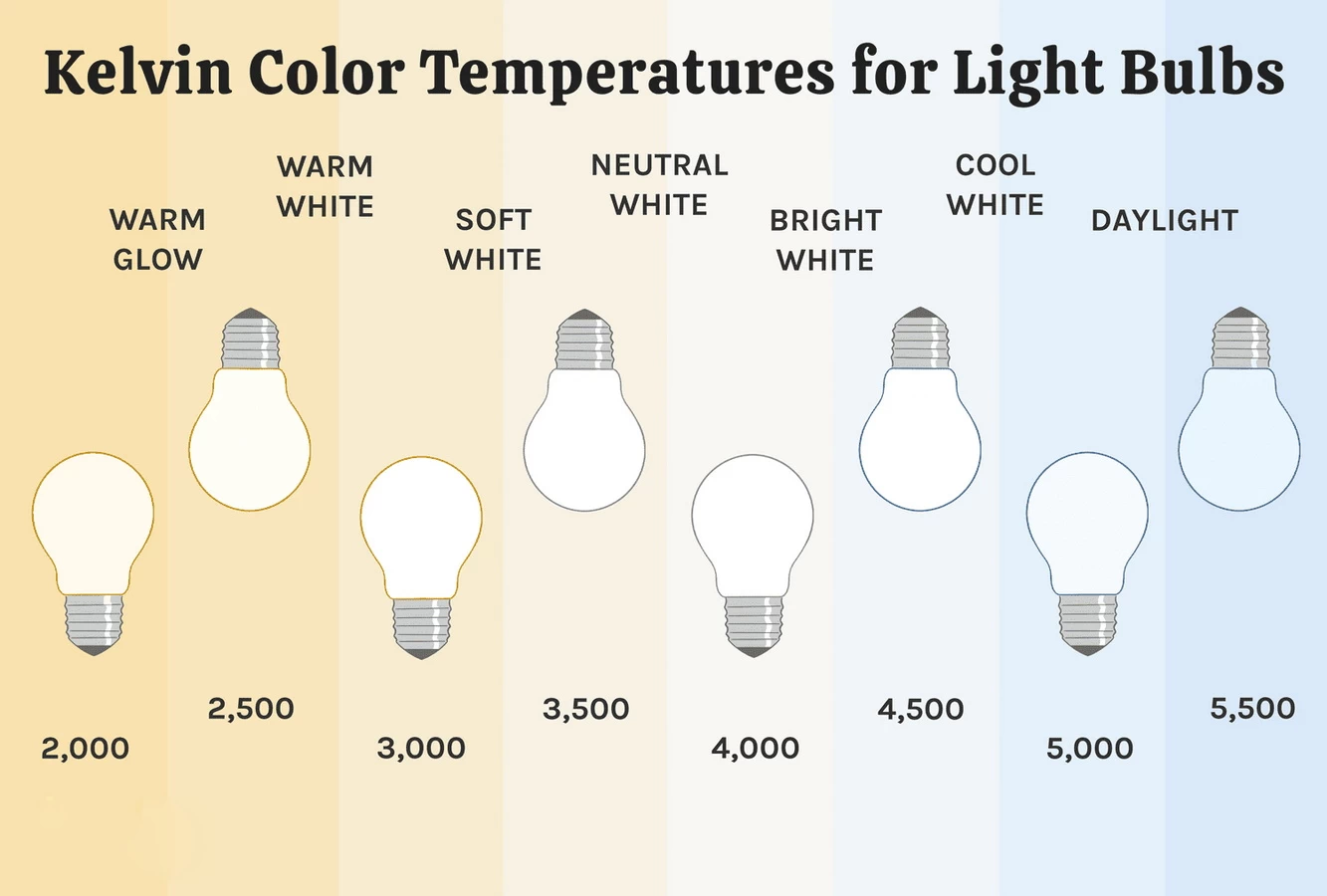
Industria, sport e applicazioni commerciali
L'illuminazione svolge un ruolo fondamentale in diversi settori:
- Applicazioni industriali
Negli ambienti industriali, l'illuminazione deve essere luminosa e affidabile. Le lampadine a luce diurna sono la scelta preferita in magazzini, fabbriche e linee di produzione. Le lampadine a luce bianca brillante sono comunemente utilizzate nelle aree che richiedono precisione e concentrazione. - Applicazioni sportive
Negli impianti sportivi, l'illuminazione deve garantire una chiara visibilità senza affaticare gli occhi. I LED Bright White e Daylight sono tipicamente utilizzati negli stadi, nelle arene e nei campi da gioco grazie alla loro elevata efficienza luminosa. - Applicazioni commerciali
Negli spazi commerciali come uffici, negozi al dettaglio e showroom, l'illuminazione crea la prima impressione. La luce diurna offre chiarezza, mentre le lampadine Soft White e Warm White creano un'atmosfera più accogliente.
Per ulteriori informazioni su come scegliere l'illuminazione per i vostri spazi commerciali, esplorate la nostra pagina dei prodotti.
Conclusione: La scelta giusta per le vostre esigenze di illuminazione
La scelta dell'illuminazione corretta implica la comprensione dei Kelvin e dei watt delle lampadine, nonché la considerazione della loro applicazione. La scelta della lampadina giusta è importante per il vostro spazio.
Per un ambiente ad alta energia, si consiglia la luce diurna o il bianco brillante. Per gli ambienti più accoglienti, la soluzione migliore è il bianco morbido o il bianco caldo. La lampadina giusta può migliorare notevolmente il comfort e la funzionalità.
Se siete pronti a cambiare la vostra illuminazione, sentitevi liberi di contattateciIl nostro team di professionisti personalizzerà le soluzioni di illuminazione per voi.
Le persone chiedono anche
Di che colore è la luce bianca morbida nell'illuminazione a LED?
La luce bianca morbida dell'illuminazione a LED è una tipica luce gialla calda a basso colore con una distinta tonalità ambrata o giallastra, simile alla luce calda delle tradizionali luci a incandescenza, al lume di candela o al tramonto. Dà una sensazione di calore, pigrizia e relax.
Il bianco freddo e il bianco brillante sembrano abbastanza simili: posso scegliere uno dei due?
Sebbene il bianco freddo e il bianco brillante siano visivamente molto simili, creano atmosfere leggermente diverse. Il bianco freddo ha spesso una tonalità bluastra, che lo rende ideale per l'illuminazione delle attività o degli spazi di lavoro. Il bianco brillante tende ad avere una tonalità leggermente più calda o fredda. Se non si cerca un'atmosfera o un effetto specifico, si può scegliere l'uno o l'altro: le differenze sono in genere minime.
Il bianco brillante è la luce LED più utilizzata? In quali scenari è più comune?
Sì, il bianco brillante è una delle temperature di colore dei LED più utilizzate. Le sue qualità luminose, neutre e naturali lo rendono una scelta popolare per molte abitazioni, spazi commerciali e industriali.
Ad esempio, in cucine, bagni, sale studio, strade, negozi al dettaglio, magazzini, corridoi di fabbriche e altro ancora.
Qual è la differenza tra il bianco vero e la luce diurna nell'illuminazione LED?
Bianco vero: temperatura di colore 4000K - 4500K, bianco neutro puro, luminoso, professionale e naturale senza riflessi. Ideale per le scene che richiedono colori reali e un'illuminazione confortevole.
Luce diurna: temperatura di colore 5000K - 6500K, bianco freddo con una tonalità bluastra. Ideale per le aree professionali che richiedono alta precisione e messa a fuoco.


